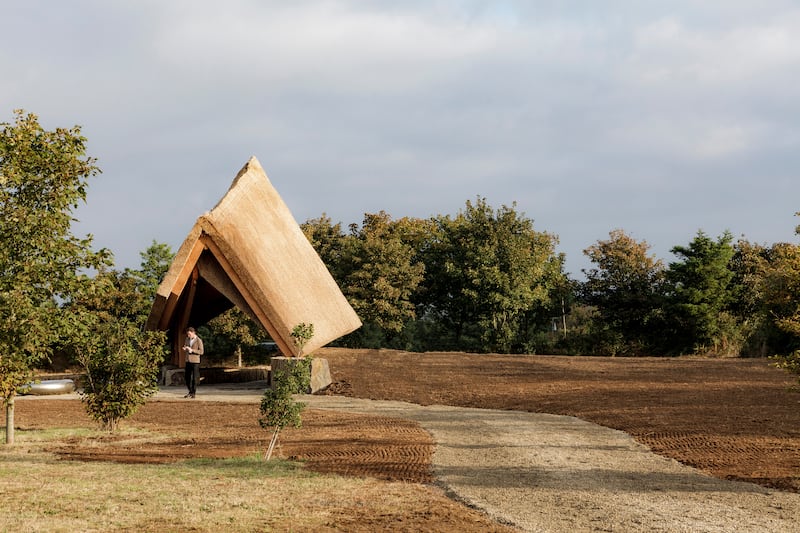Visitors to furniture-maker Joseph Walsh’s studios on the family farm near Kinsale will be greeted in the driveway by a towering equestrian sculpture by Mexican Javier MarÍn, of a man on horseback astride a replica horse and rider embedded in the earth. An even more dramatic structure on the landscape is an open-air pavilion, handmade in stone, timber and thatch without windows or walls. It’s called the Passage House and was completed in time to coincide with Walsh’s Making In symposium in September.
Constructed with locally sourced materials and honouring the associated crafts of carpentry, thatching and stonemasonry, the idea arose during the Covid-19 pandemic when Walsh, thinking about traditional materials, skills and sustainability, started a conversation with architects O’Donnell + Tuomey, with whom he has collaborated on a number of projects over the years.
“They took on the idea [of a pavilion] and working directly with the craftsmen and so the design slowly emerged from that dialogue,” says Walsh. “I got the first drawings in January and presented a scale model in March and that enabled the conversation to start.” After two more iterations of the model, “we went from it to the build – it was quite dynamic and quick”.

The building pays tribute to old Irish rambling houses, village gathering places open to all, for music and storytelling. Located on the path between Walsh’s design studio and production workshop, it is, Tuomey says, “a place of passage, a place of pause and shelter from rain. We wanted to celebrate the capacity of local craftsmanship and to test our own understanding, stretching the limits of traditional construction,” he explains.
READ MORE
The team was led by local builder Ian Scannell, who has restored several buildings on the farm. It involved Walsh’s carpenters, two stonemasons from Donegal and five thatchers. Blacksmith Mark Keeling forged the stone connection plates between the beams and the stone. “We started in June,” says Walsh. “It was totally experimental and high risk. If we were not taking some risk, we were not trying hard enough.” Scannell concurs. “It was not straightforward, but he appreciated the time and the skills it took. I have no doubt knowing him, that the next one will be even more ambitious.”
The stone floor and solid stone piers – four to five tonnes in weight – were quarried locally. Those for the drystone walls came from the farm. The structural timber was Irish-grown Douglas fir and the reeds for the thatch were cut in the shallow waters of the Shannon. “Most of the details were worked out on site together with the workmen, builders, carpenters and thatchers. There were no contract documents, no technical specifications, no detailed working drawings,” says Tuomey outlining their unconventional approach.
The Passage House came into its own on the final evening of the symposium when guests gathered there for pre-dinner drinks to marvel at its bold skeletal structure, its dry stone walls and powerful thatched canopy. For Walsh, “it shows how these materials which have served us so well for millennia can be used in a contemporary context and not just in restoration”.













